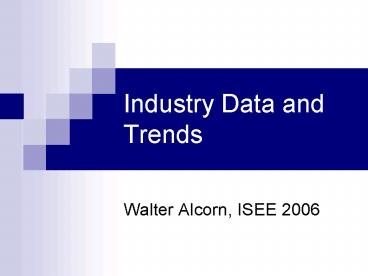Industry Data and Trends - PowerPoint PPT Presentation
1 / 23
Title:
Industry Data and Trends
Description:
In 2001 SAIC developed a simulation model of the electronics recycling industry ... monochrome TVs) in US Census data on shipments, imports, and exports, combined ... – PowerPoint PPT presentation
Number of Views:33
Avg rating:3.0/5.0
Title: Industry Data and Trends
1
Industry Data and Trends
- Walter Alcorn, ISEE 2006
2
History
- In 2001 SAIC developed a simulation model of the
electronics recycling industry as a decision
support tool for the Polymer Alliance Zone of
West Virginia - Model inputs were gathered from various
recyclers, manufacturers and industry experts
3
2001 PAZ Simulation Tool Assumptions
- There was a lively, if precarious glass-to-glass
recycling market - Remember Techneglas?
- Mixed plastics was a cost to all electronics
recyclers, not just the no export recyclers - Value of commodities were lower (steel, copper,
aluminum) - SB 20 was just an idea
4
Whats up now?
- Demand
- Commodity prices, especially metals, plastics
- Supply
- E-waste volumes
- In regulated states (CA, ME)
- Everywhere else
- Domestic recycling capacity
- Exports?
5
Demand Commodity Pricing Trends
- CRB Metals Sub-Index of 5 markets
- Copper Scrap
- Lead Scrap
- Steel Scrap
- Tin
- Zinc
- 1947 1973 prices moved within a range
- 1974 2003 prices moved within a higher range
- 2004 2006 priced moved dramatically higher, a
new range???
6
(No Transcript)
7
Supply Collection Volume Trends
- Higher overall
- Driven by
- Policy/regulation
- Financed collection programs (for households) and
- Volume potentially available
8
Policy Regulation Drivers of Supply
- State Mandates
- CA, ME, MD, WA..
- State Local Collection Programs
- Hennepin County, Delaware, Massachusetts, and
hundreds of local government collections - Regulation of business e-waste
- Business users usually not allowed to dispose of
old equipment as regular trash - Reuse patterns???
9
Mandatory State Program Volumes
- California
- Collected about 65 million pounds in their first
program year (2005) - Most was collected during the second half of the
year - With a population of 36 million thats about 1.79
lbs./capita - ME, MD, WA Amounts Still TBD
- Washington amounts TBD annually, plans to compete
to reach share threshold
10
State and Local Collection Programs
- Hennepin County the most quoted
- Developed as an extension of traditional
recycling programs (bottles, cans, paper, etc.) - Funding for these programs comes from a variety
of sources - EOL fees are common
- Landfill tipping fees
- Bottle bill proceeds
11
(No Transcript)
12
Volume of Electronics to be Recycled
- A primary question of U.S. EPAs draft Baseline
Study - Two approaches
- Review actual return amounts from existing
programs (lbs./capita) - Project amounts theoretically available from
historic sales - EPA Baseline Study to focus on amounts
theoretically at end-of-life based on historic
sales
13
Actuals Per Capita Calculations from the NCERs
CDR
- Massachusetts (2004)
- 2.94 lbs./capita (average for the 197
towns/cities reporting to the MA DEP) - Californias first program year (2005)
- 1.79 lbs/capita
- Branford, CT (2004)
- 1.61 lbs./capita (CRTs only)
- Kirkland, WA (2004, curbside program)
- 1.61lbs./capita
- Snohomish County, WA (2004, transfer station)
- 1.71 lbs./capita
- Hennepin County, MN (2004)
- 3.4 lbs./capita
14
Actual vs. Projected
- Actual returns from existing comprehensive
electronics collection recycling programs are
less than half amounts projected from sales.
Why? - Electronics are not trade-in items like car
batteries, tires - Reuse patterns not well documented nor
understood, particularly for business use
products - There is something seriously wrong with
projection models and/or data - Export?
15
Data compiled by ERG for EPA Baseline Study.
Data for desktops and portable PCs from IDC WW
Quarterly PC Tracker in October 2005. Data for
flat screen and CRT computer monitors were based
on ERG analysis of US Census data on shipments,
imports, and exports.
16
Source Data compiled by ERG for EPA Baseline
Study 2006. TV data were obtained from Consumer
Electronics Association Market Research, 2005.
The number of flat screen TVs sold was derived
from analyses of Other TVs (this category
includes flat screen and monochrome TVs) in US
Census data on shipments, imports, and exports,
combined with CEA data on monochrome TVs.
17
A Clear Trend the State Patchwork
- Many dead weight costs being studied by the
NCER as a NERIC initiative - National Electronics Recycling Infrastructure
Clearinghouse - Who incurs these dead weight costs?
- Industry
- Government
- Consumers
18
State Patchwork Costs Being Studied
- Policing/excluding out-of-state e-waste
- Inherent state-level enforcement limitations
- The continuous start-up for industry compliance
- New requirements forcing changes to IT systems
- Compliance requirements trajectory unclear
19
State Patchwork Costs Being Studied (cont.)
- Redundant program staff
- Redundant brand counts (ME, WA)
- Redundant fund administration
- Redundant reporting, registration and
recordkeeping requirements - Redundant program development engagements
20
State Patchwork Costs Being Studied (cont.)
- Higher processing costs due to
- Lower economies of scale compared with
national-scale volumes - Market fragmentation caused by state-restrictions
on out-of-state processing - State Program Financing Overlap, Over-chargers
and Free Riders - The nexus fee-collection problem in states with
advance fees
21
State Patchwork Costs Being Studied (cont.)
- Additional patchwork costs?
- Ongoing survey of industry and government
officials - The NCER seeks your input!
- info_at_ecyclingresource.org
- Website www.ecyclingresource.org
22
What We Need
- A harmonized national-level financing system
- An efficient decentralized collection
infrastructure - Systems that can evolve as needs evolve
- National ESM Standards
- Better data
- Demand for recycled materials
23
Thank You!
- For more information, contact
- Walter Alcorn
- walter_at_alcornconsulting.com
- 703-390-9200































